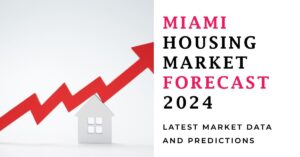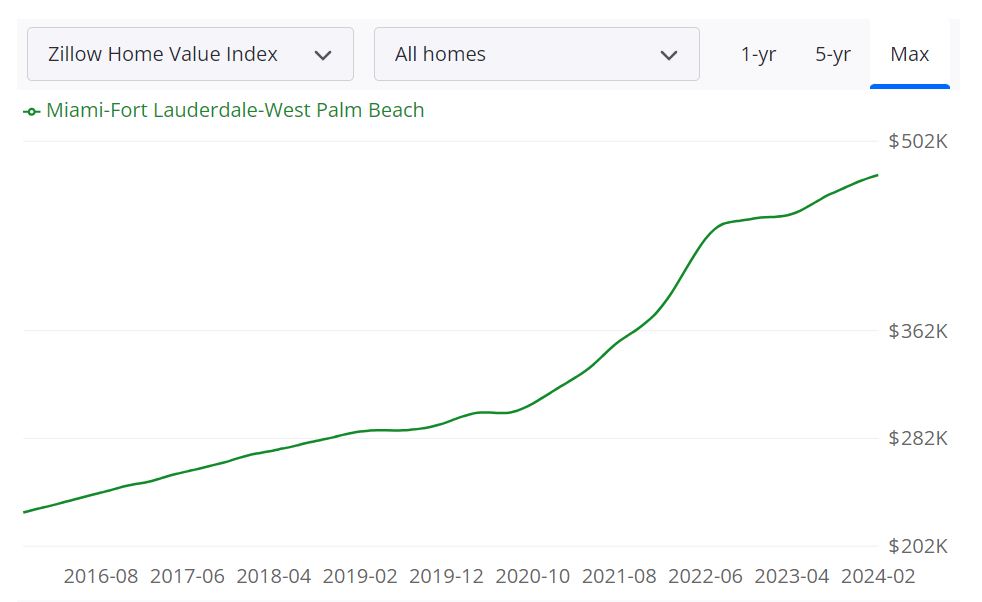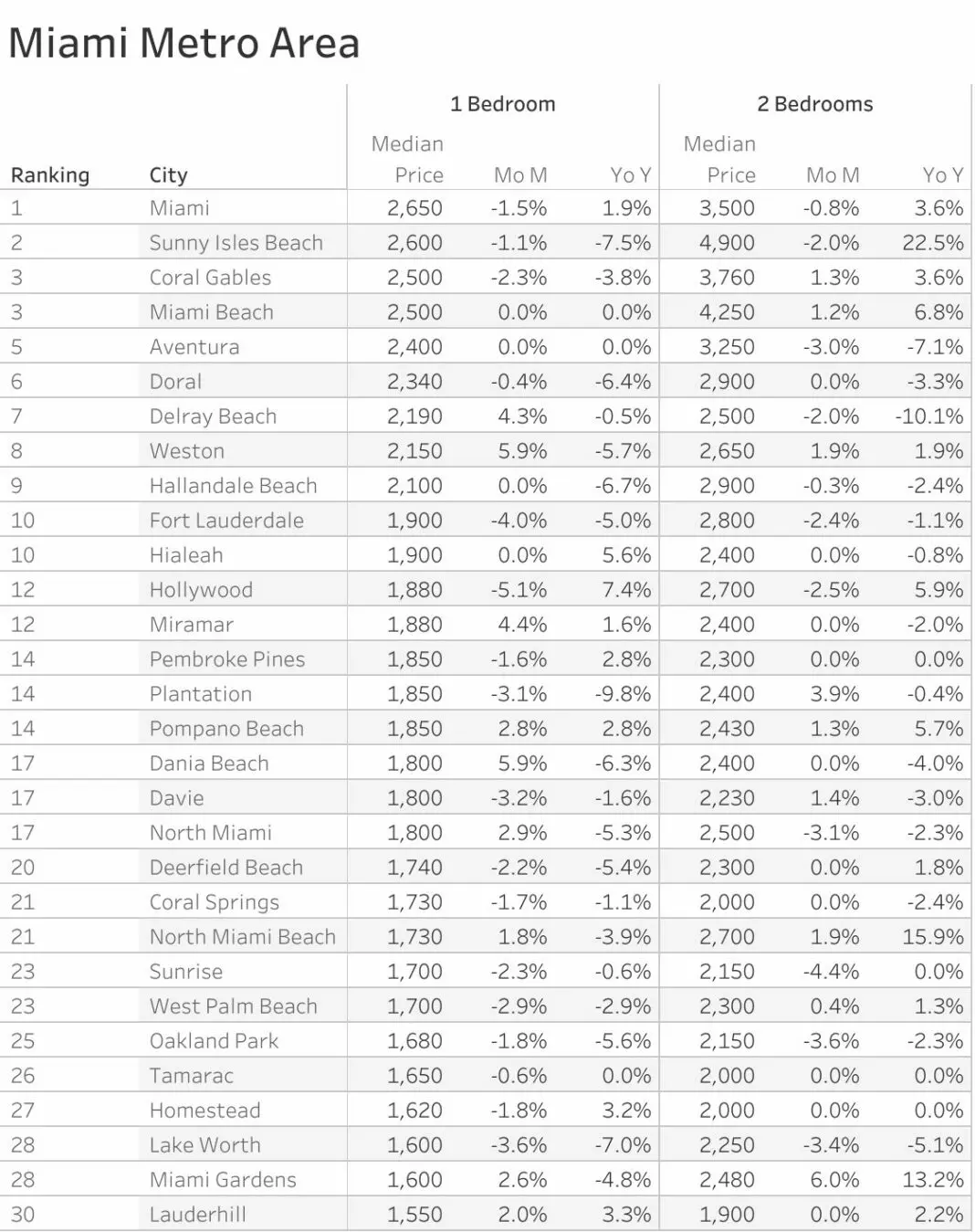Miami Real Estate Market Archives

South Florida & Miami’s housing market is strong. Despite challenges such as inventory shortages and rising mortgage rates impacting the market, Miami’s housing market continues to attract buyers, especially those from high-density, high-taxed regions. The presence of cash buyers and consistent price appreciation position Miami as a resilient and attractive real estate destination.
What are the Miami Housing Market Trends in 2024?
The Miami housing market is abuzz with activity, showing promising signs of resilience and growth despite fluctuations in the broader economic landscape.
How is the Housing Market Doing Currently?
Recent statistics released by the MIAMI Association of Realtors and the Multiple Listing Service reveal a positive trend in Miami-Dade County’s total home sales. Notably, there has been a 0.8% year-over-year increase in total home sales in February 2024, marking the second consecutive month of growth.
Miami’s allure extends beyond its sunny beaches and vibrant culture; it is also a hotspot for real estate investment, evident from its ranking as the No. 1 housing market in terms of price appreciation in the U.S. Additionally, the city leads the nation in international migration, reflecting its global appeal.
How Competitive is the Miami Housing Market?
The competitive landscape of the Miami housing market is palpable, with multiple offers becoming the norm, especially in the wake of record-high housing wealth. Single-family home sales witnessed a 5.1% year-over-year increase, indicating robust demand in this segment.
Despite a slight dip in existing condo sales, the market saw a surge in mid-market condo sales, particularly in the $400,000 to $600,000 price range. However, inventory constraints at key price points and elevated mortgage rates have impacted condo sales to some extent.
Are There Enough Homes for Sale to Meet Buyer Demand?
While the Miami housing market is thriving, there are lingering concerns regarding inventory levels. Total inventory remains 37.3% below the historical average for the region, posing challenges for prospective buyers.
However, there’s a glimmer of hope as total active listings witnessed a 23.7% year-over-year increase, offering some relief to buyers. The rise in new listings, nearing pre-pandemic levels, has diversified the options available to homebuyers.
What is the Future Market Outlook for Miami?
Despite inventory constraints, Miami’s real estate market continues to exhibit resilience, underpinned by 12+ years of consecutive home price appreciation. Single-family home median prices soared 17.1% year-over-year in February 2024, reaffirming the city’s status as a lucrative investment destination.
Moreover, Miami remains a value proposition compared to other global cities, offering more prime property per dollar. This comparative advantage enhances its attractiveness to both domestic and international investors.
Is Miami a Buyer’s or Seller’s Housing Market?
The current dynamics suggest that Miami’s housing market leans towards being a seller’s market. With 4.4 months supply of inventory for single-family homes, the market favors sellers, driving competition and influencing pricing trends.
Conversely, the existing condominium segment reflects a balanced market, with 7.8 months supply of inventory. This equilibrium between supply and demand offers a more level playing field for both buyers and sellers.
Miami Housing Market Predictions for 2024 and 2025
The Miami metropolitan area is the seventh-largest metropolitan area in the United States and the 72nd-largest metropolitan area in the world. The metropolitan area includes the City of Miami (the financial and cultural core of the metropolis), Miami-Dade, Broward, and Palm Beach counties which are the first, second, and third most populous counties in Florida. Greater Miami includes a larger area defined by the United States Census Bureau as the Miami-Port St. Lucie-Fort Lauderdale Combined statistical area.
This larger area includes Martin, Saint Lucie, and Indian River counties to the north of Palm Beach County. So, what are the Miami real estate market predictions for 2024 and 2025?
According to Zillow, the average home value in the Miami-Fort Lauderdale-West Palm Beach area stands at $477,917, reflecting a 7.0% increase over the past year. Homes in this region typically go pending in approximately 38 days.
Key Metrics Explained:
- For Sale Inventory: As of February 29, 2024, there were 40,504 properties listed for sale in the Miami area. This metric provides insight into the overall supply of homes available for purchase.
- New Listings: In February 2024, 10,019 new listings entered the market. New listings indicate fresh opportunities for buyers and often influence market dynamics.
- Median Sale to List Ratio: The median sale to list ratio, which was 0.970 as of January 31, 2024, illustrates the relationship between the final sale price of a property and its initial listing price.
- Median Sale Price: As of January 31, 2024, the median sale price for homes in Miami was $435,000, offering a snapshot of the midpoint value in the market.
- Median List Price: The median list price, recorded at $537,967 as of February 29, 2024, represents the midpoint of all listed properties’ prices, serving as a reference for both buyers and sellers.
- Percent of Sales Over/Under List Price: These percentages indicate the prevalence of homes selling above or below their listed prices. As of January 31, 2024, 11.7% of sales were over list price, while 73.8% were under list price, reflecting varying market dynamics.
Before analyzing the forecasted trends, it’s essential to define the Miami Metropolitan Statistical Area (MSA) and its constituent counties. The Miami MSA encompasses Miami-Dade, Broward, and Palm Beach counties, constituting one of the largest housing markets in the United States.
Miami-Dade County is the southernmost county in Florida, renowned for its vibrant culture, diverse communities, and bustling urban centers. Broward County lies north of Miami-Dade and boasts a mix of urban and suburban neighborhoods, while Palm Beach County stretches further north, offering upscale coastal living and picturesque landscapes.
The Miami housing market’s size, influenced by factors such as population growth, economic trends, and real estate development, remains substantial. Its bespoke characteristics cater to a diverse range of buyers and investors, making it a robust and dynamic arena for real estate transactions.
Forecast:
Looking ahead, Zillow’s 1-year Market Forecast predicts a 2.5% increase in the Miami housing market by February 28, 2025. This forecast considers various factors, including economic indicators, demographic trends, and market sentiment, providing valuable insights for stakeholders in the real estate industry.
Is Miami a Buyer’s or Seller’s Housing Market?
Assessing whether the Miami housing market favors buyers or sellers involves examining various indicators, including inventory levels, pricing trends, and market competitiveness. With 40,504 properties listed for sale as of February 29, 2024, and a median sale to list ratio of 0.970, indicating that homes are typically selling close to their listed prices, the market leans towards sellers. Additionally, the prevalence of 11.7% of sales being over list price further signifies seller dominance, suggesting that buyers may encounter challenges such as bidding wars and limited options.
Are Home Prices Dropping in Miami?
Despite occasional fluctuations, the data indicates a general upward trend in home prices within the Miami housing market. As of January 31, 2024, the median sale price stood at $435,000, reflecting sustained demand and market appreciation. While short-term variations may occur due to factors like economic conditions and seasonal influences, the overall trajectory suggests stability and potential for further growth rather than a significant decline in prices.
Will the Miami Housing Market Crash?
Forecasting a housing market crash requires a comprehensive analysis of numerous economic, demographic, and policy factors, making precise predictions challenging. While periodic corrections and adjustments are inherent to real estate markets, indicators such as steady demand, limited inventory, and favorable economic conditions mitigate the likelihood of a sudden and severe crash in the Miami housing market. However, ongoing monitoring of market dynamics and prudent risk management remain essential for all stakeholders.
Is Now a Good Time to Buy a House in Miami?
Determining whether it’s an opportune time to purchase a home in Miami involves considering individual circumstances, financial readiness, and long-term objectives. While factors like low interest rates and favorable market conditions may present attractive opportunities for buyers, the competitive landscape and rising prices necessitate careful consideration and strategic planning. Consulting with real estate professionals and conducting thorough market research can help prospective buyers make informed decisions tailored to their specific needs and goals.


Should You Invest in the Miami Real Estate Market?
Population Growth and Trends
When considering investment in the Miami real estate market, population growth and trends play a pivotal role. Miami’s population has been steadily growing over the years, driven by both domestic and international migration. Here’s why this matters for investors:
- Population Growth: Miami’s population has been on an upward trajectory, attracting residents from all over the United States and abroad. This influx of people creates a consistent demand for housing, making it an attractive market for real estate investors.
- International Appeal: Miami’s international appeal is a significant driver of population growth. The city’s vibrant culture, pleasant climate, and international business connections make it a magnet for individuals from around the world. For investors, this diverse population presents opportunities in various real estate sectors, including residential and commercial properties.
Economy and Jobs
Examining the economy and job market is critical for real estate investment decisions:
- Economic Strength: Miami boasts a diverse and robust economy. It’s a hub for international trade, tourism, finance, and technology. A strong and diversified economy helps ensure a stable demand for real estate, both for commercial and residential purposes.
- Job Opportunities: The availability of job opportunities in Miami is a key factor for real estate investors. A thriving job market attracts professionals, and this, in turn, leads to higher demand for rental properties, as many newcomers prefer renting initially.
Strong International Market
Miami’s real estate market benefits from a strong international presence:
- Global Investment: Miami is a favored destination for international investors. Buyers from South America, Europe, and other regions consider Miami a safe and attractive place to invest in real estate. As an investor, you can tap into this global demand for properties.
- Foreign Investment: Foreign investors often seek properties in Miami for various purposes, including vacation homes, second residences, and income-generating rental properties. This international interest adds stability and growth potential to the local market.
Livability and Other Factors
Livability and lifestyle factors contribute to the city’s attractiveness:
- Lifestyle Appeal: Miami’s lifestyle, with its beautiful beaches, cultural attractions, and vibrant nightlife, makes it an appealing place to live. This lifestyle appeal increases demand for both residential properties and rental units.
- Weather and Climate: Miami’s tropical climate is a major draw for residents and tourists alike. The city’s pleasant weather encourages year-round tourism and can contribute to the demand for rental properties.
Big Rental Property Market Size and Its Growth for Investors
Miami offers a thriving rental market:
- Rental Demand: The city’s diverse population, strong job market, and international appeal create a substantial demand for rental properties. This is advantageous for real estate investors, as it means a steady stream of potential tenants.
- Rental Income Potential: Miami’s rental market has significant income potential. Depending on the neighborhood and property type, investors can generate attractive rental income. High rental rates can translate into favorable cash flow for property owners.
The Zumper Miami Metro Area Report analyzed active listings last month across the metro cities to show the most and least expensive cities and cities with the fastest growing rents. The Florida one bedroom median rent was $1,682 last month. Miami was the most expensive city with one-bedrooms priced at $2,650. Lauderhill ranked as the least expensive city with rent at $1,550.
Here are the top cities in the metro area where rents are increasing. You can think of investing in these places because they have strong growth and demand for rental properties. You can also use their historical annual growth in rents to help predict future increases or decreases.
The Fastest Growing Cities in Miami Metro Area For Rents (Y/Y%)
- Hollywood had the fastest growing rent, up 7.4% since this time last year.
- Hialeah saw rent climb 5.6%, making it second.
- Lauderhill ranked as third with rent increasing 3.3%.
The Fastest Growing Cities in Miami Metro Area For Rents (M/M%)
- Dania Beach & Weston had the largest monthly rental growth rates, both up 5.9%.
- Miramar rent increased 4.4% last month, making it second.
- Delray Beach was third with rent climbing 4.3%.


Other Factors Related to Real Estate Investing
When contemplating investment in the Miami real estate market, it’s essential to consider these additional factors:
- Market Trends: Staying informed about market trends, such as price appreciation, rental rates, and property supply, is crucial. These trends can influence your investment strategy.
- Local Regulations: Understanding local real estate regulations, property taxes, and zoning laws is vital for investors to navigate the market effectively.
- Property Management: Whether you plan to manage properties yourself or hire a management company, efficient property management is key to successful real estate investments.
- Diversification: Consider diversifying your real estate portfolio in Miami by exploring different property types, from single-family homes to commercial properties.
Highest Appreciating Miami Neighborhoods
When considering real estate investments, it’s crucial to evaluate the historical performance of neighborhoods. The following Miami neighborhoods have demonstrated significant appreciation since 2000, making them noteworthy areas for potential investors:
Downtown North
- **Appreciation**: Downtown North has experienced substantial appreciation in real estate values over the past two decades. This makes it an attractive prospect for investors seeking long-term growth.
- **Location**: Situated in the heart of Miami’s downtown area, Downtown North offers proximity to key amenities, cultural attractions, and business centers.
- **Potential**: With its central location and upward trend in property values, Downtown North presents opportunities for investors interested in urban real estate.
Little Haiti South
- **Appreciation**: Little Haiti South has seen remarkable appreciation since 2000. This neighborhood’s transformation has been driven by its cultural vibrancy and proximity to downtown Miami.
- **Cultural Hub**: Little Haiti South has become a cultural hub, attracting artists, creatives, and entrepreneurs. This cultural renaissance has boosted its real estate market.
- **Investment Appeal**: Investors seeking neighborhoods with both historical significance and growth potential should consider Little Haiti South.
Overtown North
- **Appreciation**: Overtown North’s appreciation over the years highlights its potential for real estate investment. This historic neighborhood has witnessed resurgence.
- **Revitalization**: Overtown North has been a focus of revitalization efforts, leading to improved property values and a growing sense of community.
- **Investor Opportunities**: For those interested in contributing to the revitalization of a historic neighborhood while realizing financial gains, Overtown North is a compelling choice.
Overtown West
- **Appreciation**: Overtown West has undergone a transformation, with appreciating real estate values. This neighborhood showcases the potential for investors in areas undergoing positive change.
- **Community Development**: Overtown West’s development initiatives have contributed to its growth. Investors can participate in community development projects while benefiting from rising property values.
- **Future Prospects**: Overtown West is a neighborhood to watch for those interested in urban redevelopment and investment in emerging areas.
Downtown Southeast
- **Appreciation**: Downtown Southeast’s real estate market has shown consistent appreciation over the years. Its location and urban development make it an appealing choice for investors.
- **Urban Development**: Downtown Southeast has witnessed significant urban development, including new residential and commercial projects. This development has boosted property values.
- **Investment Potential**: With its ongoing urban transformation, Downtown Southeast presents promising investment opportunities for those looking to capitalize on urban growth.
Downtown Northwest
- **Appreciation**: Downtown Northwest has experienced notable appreciation in real estate values since 2000. Its proximity to downtown Miami and growth in infrastructure contribute to its appeal.
- **Proximity to Downtown**: The neighborhood’s location near downtown Miami is a key factor driving appreciation. Residents enjoy easy access to the city’s business and entertainment districts.
- **Investor Advantages**: Downtown Northwest offers advantages for investors seeking a strategic location and potential for long-term appreciation.
Downtown
- **Appreciation**: The central Downtown area of Miami has consistently appreciated in real estate values. Its status as the city’s core business and cultural district contributes to this growth.
- **Economic Hub**: Downtown Miami is an economic hub, home to numerous businesses, cultural institutions, and entertainment venues. This dynamic environment supports property value growth.
- **Investment Opportunities**: Investors looking for real estate in the heart of the city should consider Downtown Miami, given its appreciation potential and urban vibrancy.
Downtown East
- **Appreciation**: Downtown East has seen substantial appreciation, benefiting from its location within Miami’s thriving downtown district.
- **Urban Growth**: Downtown East has experienced growth in both residential and commercial developments. This urban expansion has contributed to property value appreciation.
- **Investment Appeal**: Investors interested in neighborhoods within the urban core of Miami should explore Downtown East’s potential for investment and growth.
Town Square
- **Appreciation**: Town Square’s appreciation since 2000 makes it a noteworthy area for real estate investors seeking long-term gains.
- **Location**: The neighborhood’s location offers accessibility to key amenities and is situated in a dynamic urban environment that supports property value growth.
- **Investment Prospects**: Town Square provides investment prospects in a vibrant urban setting, making it a compelling choice for real estate investors.
Park West
- **Appreciation**: Park West has demonstrated significant appreciation over the years, positioning it as an attractive area for investors.
- **Urban Development**: Park West has witnessed urban development, including entertainment venues and commercial establishments. This development has enhanced property values.
- **Investor Opportunities**: Park West offers investment opportunities in a growing urban district with the potential for long-term appreciation.
References:
- category/news-releases/

.jpg)
